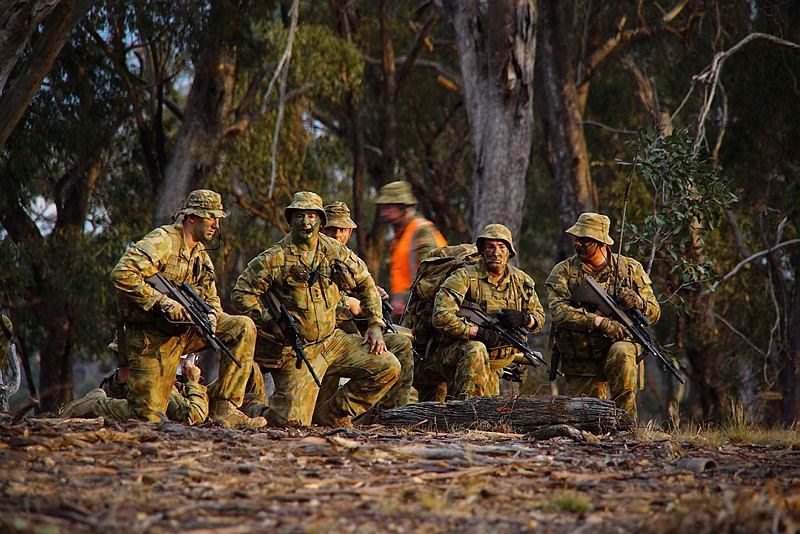The locus of the Australian Army’s combat capability is the soldier—male or female, combat or combat support. While it would be fair to say that large-scale equipment platforms such as ships, submarines and aircraft are central to maritime and air power, the nucleus of Army’s contribution to the joint force is the ‘human platform’.
Army has crafted a simple, deliberate, tailored and balanced approach to perpetually modernise its principal capability. It’s underpinned by four pillars of logic.
First, Army defines the capability of its combat soldier via the Soldier Combat System (SCS). The SCS comprises the following six dynamic, interlinked sub-systems:
- Lethality – enabling our soldiers to employ lethal and non-lethal force.
- Survivability – ensuring Army’s ‘human platform’ can survive physical and psychological attack, while also withstanding adverse environmental conditions.
- Mobility – enabling the soldier to move and remain agile, irrespective of geography.
- Situational awareness – allowing the soldier to know and act more quickly than potential adversaries.
- Sustainability – keeping our people effective on the battlefield at all times, no matter the exigencies of their situation.
- Education and Training – giving our soldiers the means to transform equipment into capability.
To borrow Aristotle’s axiom, the ‘holistic value’ of these SCS sub-systems ‘is greater than the sum of their individual parts.’ However, these systems are, at once, interdependent and in competition with each other. Enhancing one invariably compromises another. Achieving an optimal ’sum’ is as much a science as it is an art.
By example, let’s say Army decides to increase the survivability of soldiers by issuing them a heavier, larger and more robust ballistic plate system. By enhancing soldier survivability, Army has prejudiced their mobility and sustainability. This trade off may have additional implications for the soldier’s lethality and situational awareness as factors such as fatigue and resupply come into consideration.
Second, Army equips its soldiers according to their ‘Tier’, of which there are three. Broadly speaking, Tier 1 Combatants perform niche tasks, such as combat diving or military free fall parachuting. Tier 2 Combatants fight either on foot in the dismounted role or while mounted in Armoured Fighting Vehicles (AFVs). Tier 3 combatants provide general support to combined arms teams. This tiering approach has nothing to do with a soldier’s status; rather, it allows Army to tailor combat equipment to the specific needs of its combatants.
How does this manifest? Tier 2 Dismounted combatants are now issued, will be issued or are testing tailored load carriage equipment, weaponry, target acquisition ancillaries, night fighting equipment, signature reduction devices, surveillance devices, clothing, boots and small vehicles. This kit will make them more lethal, survivable, mobile, sustainable and situationally aware than ever. Tier 2 Mounted and Tier 3 Combatants are increasingly issued or evaluating combat equipment specifically designed to best enable them to perform their various, and often unique, roles and tasks.
Army is also working closely with industry to deliver a new large assault pack that will likely fit 95% of Army’s female combatants. How does this compare to the large field pack issued since around 1994? According to Defence Science and Technology Group anthropometric data, the legacy pack fits none of Army’s females. Tier 2 Combatant marksman, commanders, infantry, combat engineers, joint fire teams and AFV crews will be provisioned with the Enhanced F88 rifle of varying lengths, bipods, day sights, night sights, thermal sights and target acquisition ancillaries. Why? Because the EF88 configuration optimised for combat shooting by Tier 2 Dismounts may not fit in an AFV gun rack—nor be required by Tier 2 Mounted soldiers due to the nature of their role as operators of armoured vehicles in a combined arms team. All of these variations have been deliberately tailored to meet the requirements of combatants performing specific roles and functions.
The third pillar is that the realities of the commercial environment impact how Army modernises its core capability. Technological maturity, commercial reliability, manufacturing capacity, affordability and world-wide demand shape what Army can realistically achieve in a suitable timeframe.
A perennial, and often vexing, modernisation necessity is the quest for constant improvement and the avoidance of obsolescence. The rate of technology advancement means that cutting-edge capabilities delivered today invariably lose their technical advantage as soon as tomorrow dawns. This is the world we live in. As individuals, we confront the same reality when the personal fixed-contract smart phone we acquire is outsmarted by the latest device.
It’s unrealistic to expect Army to be able to update most capabilities as quickly as many of us progress to the latest smart phone. However, what Army must do is constantly seek ways and means to either improve or replace current capabilities. Doing so mitigates the inexorable loss in capability advantage over time.
To address this existential issue, Army has built, ‘adaptive acquisition’ features into many of its soldier modernisation initiatives. This is the fourth logic pillar underpinning Army’s continuous modernisation of its cardinal capability. This approach ensures that the leading load carriage equipment, weapons, ancillaries, radios and human performance initiatives Army delivers in 2015 are not obsolete in 2025.
Army is constantly seeking to enhance the equipping, or modernisation, of its central capability, the soldier. In recent times, it has crafted a simple, deliberate, tailored and balanced, approach for modernising this principal capability. It’s working with other services and groups within Defence, as well as industry, to realise this modernisation effect on an enduring basis.


